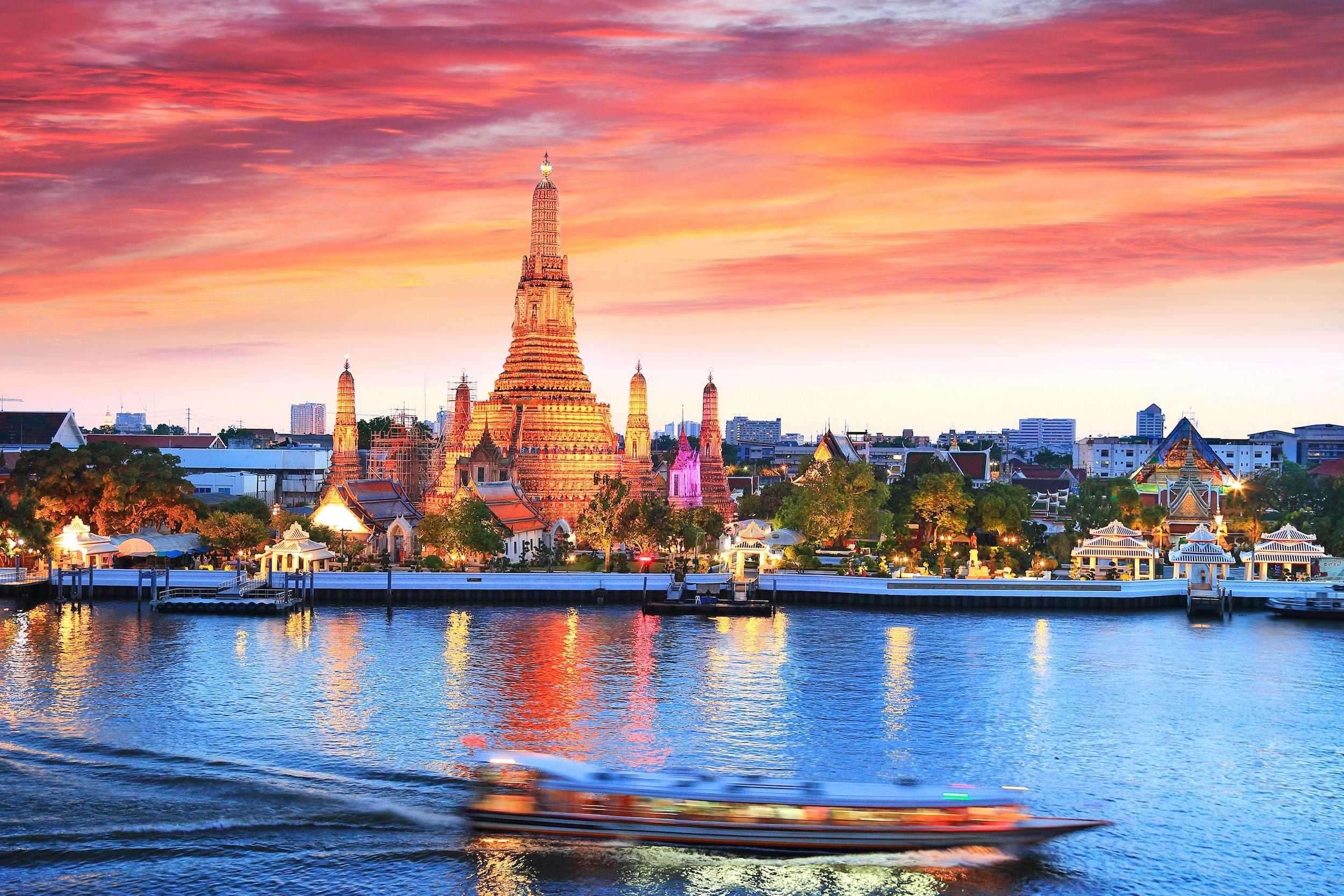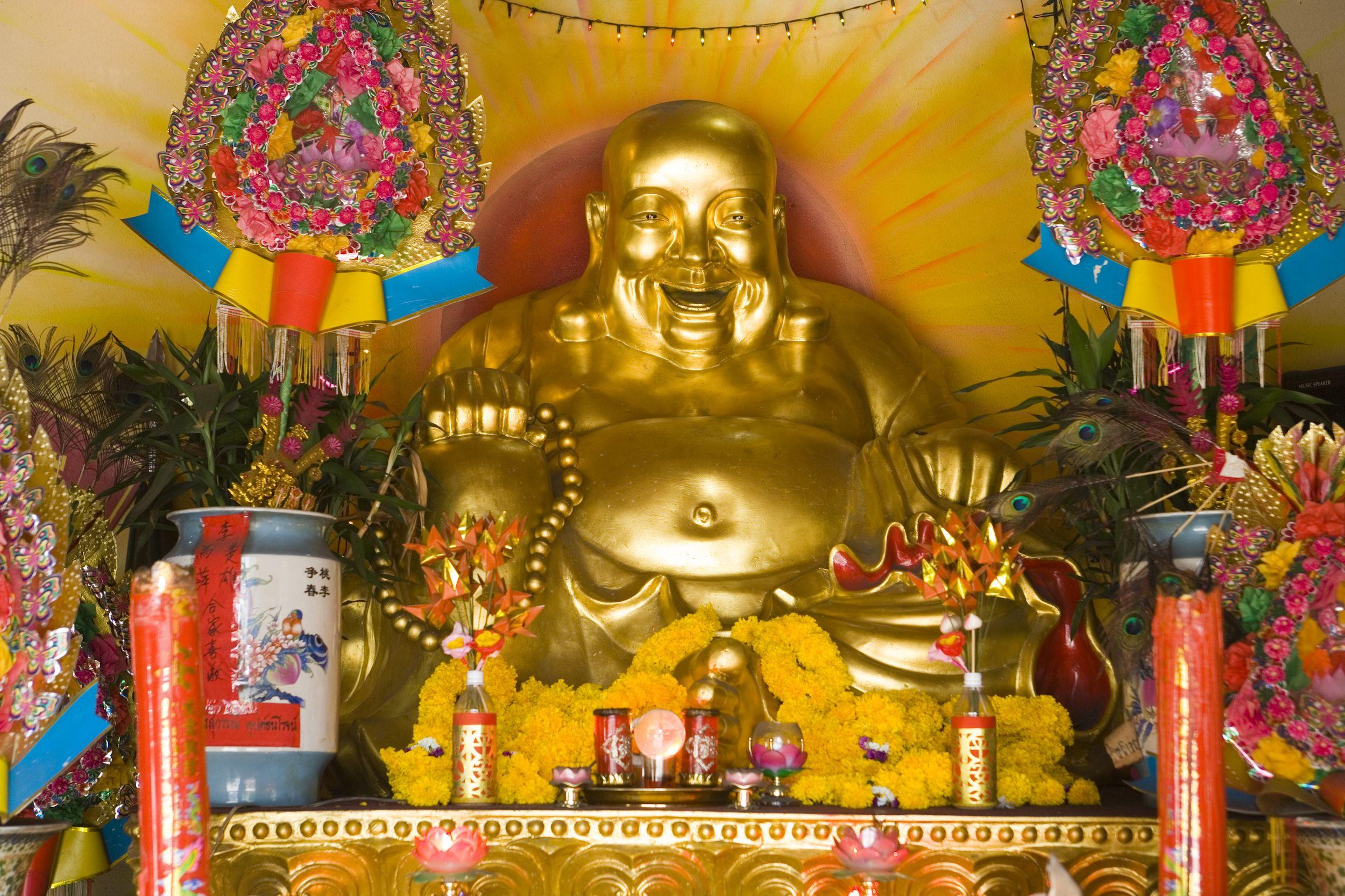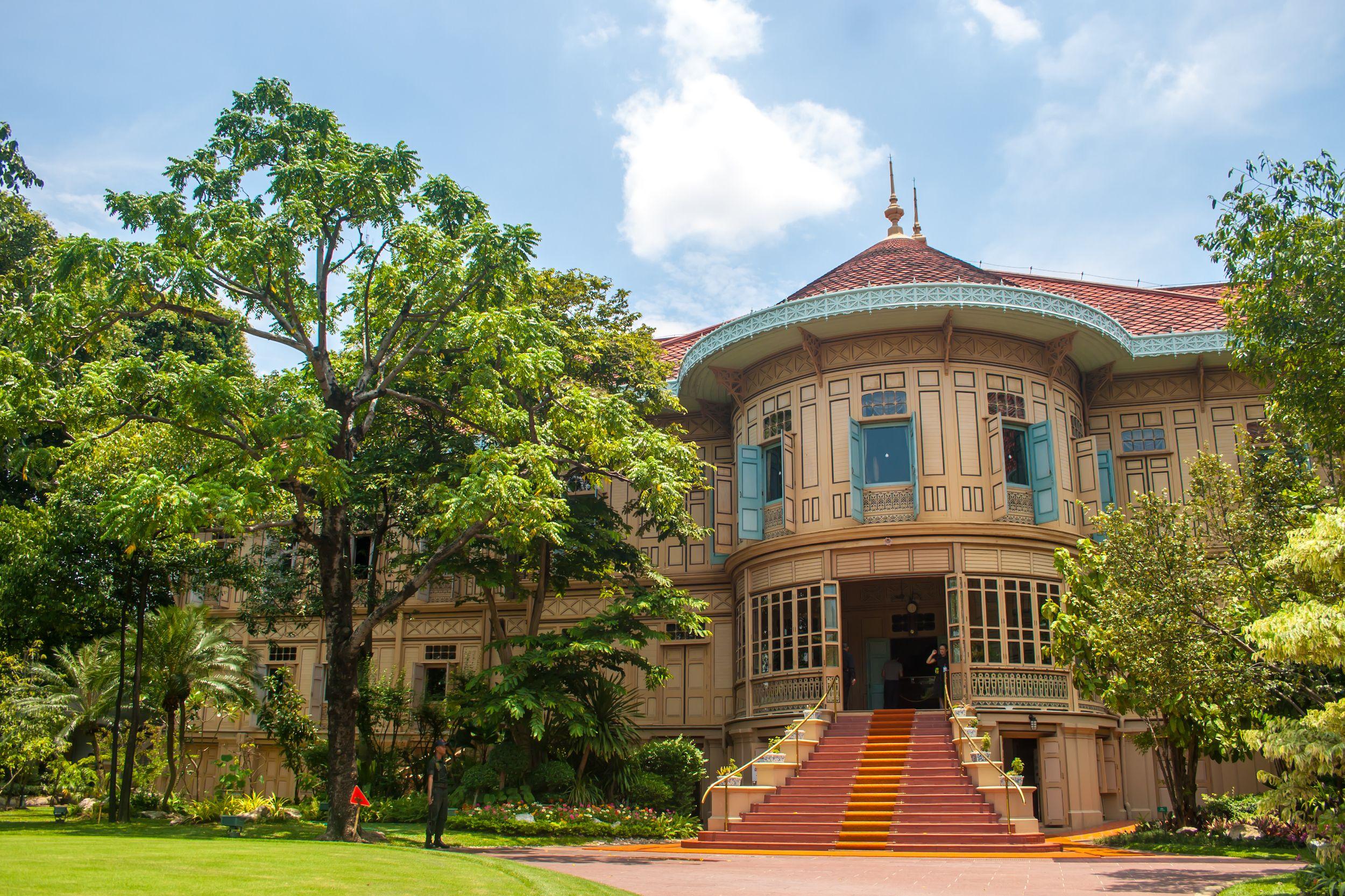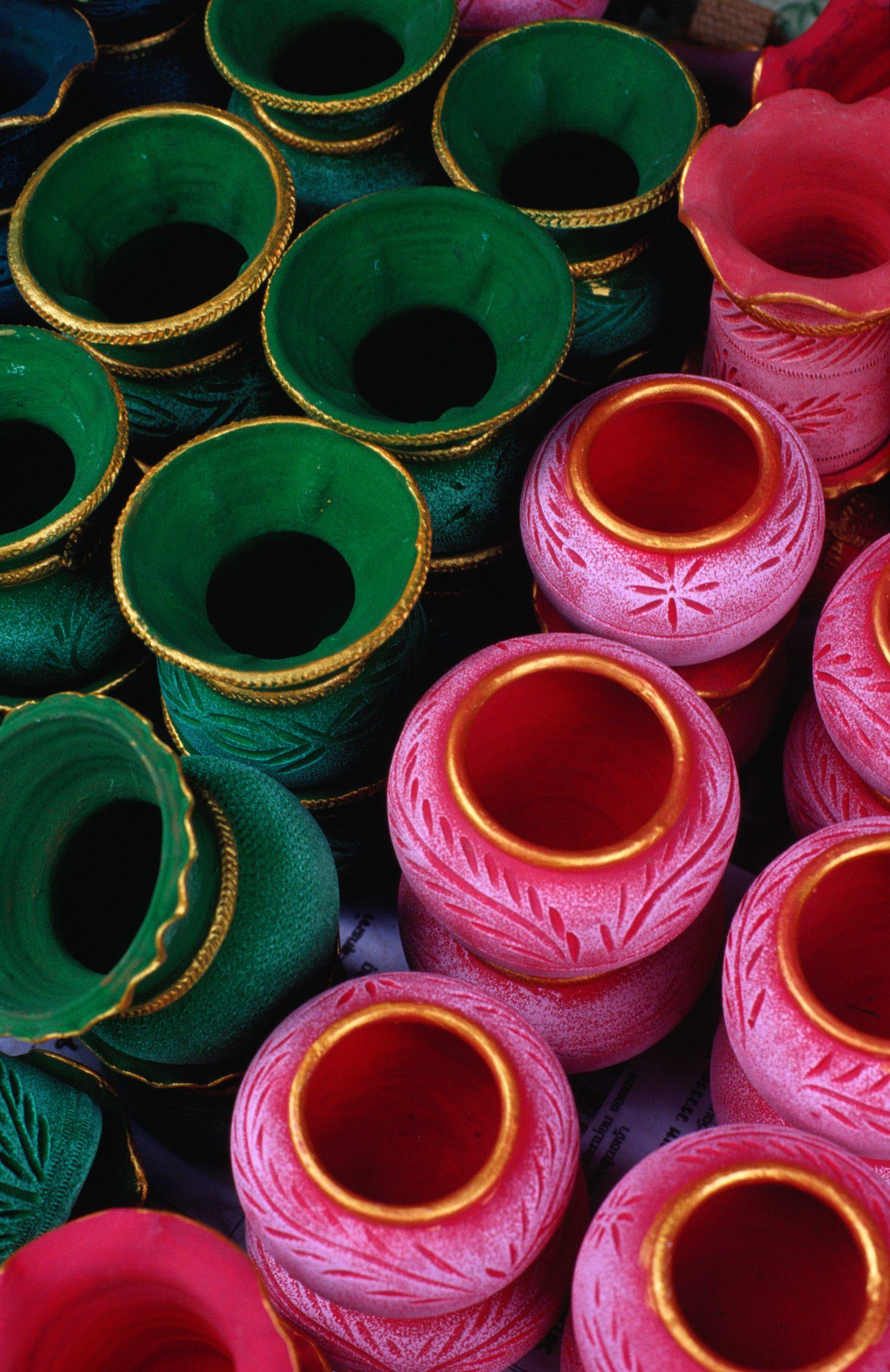The rumours are true: everything you have heard about Bangkok is true. But the Thai capital is so much more. Bangkok is an eclectic hodgepodge of glass skyscrapers rising next to glittering Buddhist temples, monks sharing the pavements with fashionable teenagers, open-air markets bordering air-conditioned shopping malls, where everyone can find something interesting, a must-see on a 15-day tour of Thailand. In order not to get completely lost, here are what not to miss: eight must-see attractions to see the best of the city.
The skyline of Bangkok and Lumpini Park, Thailand ©9aTTh/Getty Images
1. Chatuchak weekend market
Try to imagine all the markets in Bangkok merged together, add an artistic touch, a Turkish bath atmosphere and people intent on haggling to the picture and there you have Chatuchak. You will feel as if you have ended up in a chaos with no way out, but in reality it is all organised into fairly coherent sectors where you will find statues of Buddha, contemporary artwork, clothes used by Thai youth of various subcultures - from punks to cowboys-, brass woks and of course many snacks and Thai specialities will help you cope with the exertions of your visit to Chatuchak, avoiding the bad mood due to dehydration or hunger.
The Wat Phra Kaew, Bangkok ©PHOTO BY PRASIT CHANSAREEKORN/Getty Images
2. Wat Phra Kaew and the Grand Royal Palace
Also known as the Temple of the Emerald Buddha, Wat Phra Kaew is the colloquial name given to the vast, fairy-tale complex housing the Royal Grand Palace, once the residence of Thai rulers.
The Emerald Buddha
On a high platform located in the beautifully decorated bòht (ordination hall) of Wat Phra Kaew stands the Emerald Buddha, the temple's most precious jewel. The extraordinary ornamentation inside and outside the shrine captures the attention of those entering for the first time more than the statuette, which stands just 66 centimetres tall and is placed so high above the worshippers that it is less impressive than the gilded building that houses it. Despite its name, the image is carved from a single piece of nephrite (a type of jade).
Guardians of Wat Phra Kaew
The first statues you will see on entering Wat Phra Kaew are two five-metre tall yakshas, giants or orcs from Hindu-Buddhist mythology. Other mythical figures in the complex include kinaree (half-man, half-bird creatures), sacred birds called garuda, as well as numerous elephants and hermit figures.
The striking Wat Arun, Bangkok ©seng chye teo/Getty Images
3. Wat Arun
This curiously missile-shaped temple standing on the banks of the Mae Nam Chao Phraya is better known as the Temple of Dawn, a name derived from the Indian aurora deity, Aruna. It was here that, after the destruction of Ayuthaya, King Taksin came across a small shrine, a fact he interpreted as a sign that this was to be the site of Siam's new capital.
The Tower
The centrepiece of Wat Arun is the 82-metre-high Khmer-style þrahng (tower), built in the first half of the 19th century by Rama II. From the river you can't help but notice that this cob-shaped spire is adorned with colourful floral motifs in glazed porcelain, a common decoration in temples of the early Ratanakosin period, when this material was used as ballast by Chinese ships calling at Bangkok.
What to see in Wat Arun
Many people visit Wat Arun on long tail boat excursions, but it is easy and far more rewarding to take the 3B river ferry from Tha Tien. After the crossing you can get away from the river and take a walk along Th Wang Doem, a quiet cobbled street lined with wooden shophouses.
Buddha at Wat Tramit temple, Bangkok ©Greg Elms/Lonely Planet
Sign up for our newsletter! For you weekly travel tips, special offers, stories from around the world and 30% discount on your first order.
4. Wat Traimit (Golden Buddha)
Better known as the Temple of the Golden Buddha, Wat Traimit houses the world's largest golden statue, a gleaming three-metre tall, 5.5-tonne Buddha image with a mysterious past. It is believed to date back as far as the 13th century, but if a Buddha image can have a second life, this is most likely the case.
The Golden Buddha
The golden Buddha statue is the big attraction at Wat Traimit. Situated on the fourth floor of the temple's imposing marble structure, the sculpture was 'discovered' sixty years ago under a layer of stucco or plaster, after falling from a crane that was moving it. The covering is believed to have been made to protect the statue from raids, perhaps in the late Sukhothai era or later, in the Ayuthaya era, when the city was under siege by the Burmese.
The ruins of Chai Watthanaram©cowardlion/Shutterstock
5. Ayuthaya
Ancient ruins, a rural atmosphere, tasty cuisine and quality hotels, all within an hour of Bangkok. Ayuthaya was the capital of Siam from 1350 and an important trading port, where merchants gaped at the rich temples and palaces. This golden age came to an end in 1767, when the Burmese army invaded and sacked the city, carrying off most of its treasures. In 1991, the ruins of Ayuthaya were declared a UNESCO World Heritage Site.
Ayutthaya Tourist Centre
The Ayutthaya Tourist Centre should be your first stop in Ayuthaya, as the excellent exhibition on the first floor reconstructs the general context and describes the ancient glories of the city.
Ayuthaya Historical Park
The ruins of the ancient capital are located in two distinct areas: 'on the island' in the central part of the city, which can be visited comfortably by bicycle or motorbike, and 'off the island', on the opposite bank of the river from the centre, which is best reached by an evening boat trip. Among the most interesting remains 'on the island' are Wat Mahathat and Wat Phra Si Sanphet. Don't miss 'off the island' the Wat Chai Wattanaram.
The Vimanmek Palace (Phra Thinang Wiman Mek), Bangkok ©ajisai13/Shutterstock
6. Dusit Palace Park
Following his first trip to Europe in 1897, Rama V returned home with images of European castles and set out to transpose those styles into an authentically Thai creation. Thus the present Dusit Palace Park was born. Today, the ruler resides in another residence and this complex houses a museum and other cultural collections.
Vimanmek Teak Mansion
First built at Ko Si Chang in 1868 and moved to its current location in 1910, this mansion has 81 rooms including halls and antechambers, and is said to be the world's largest gilded teak building, constructed - we are told - without using a single nail.
The pottery in the Mon village of Kwan-A-Man, Ko Kret ©Richard I'Anson/Lonely Planet
7. Ko Kret
Ko Kret, the easiest green oasis to reach from Bangkok, is an island that was formed almost three centuries ago by the digging of a canal to shorten a bend in the Mae Nam Chao Phraya River. It is home to one of the oldest settlements of the Mon ethnic group, who dominated central Thailand from the 6th to the 10th century. Today Ko Kret is known for its pleasant rural atmosphere, characteristic pottery and lively market held every weekend.
Pottery
Ko Kret is famous for its beautiful handmade earthenware pots, which can be bought in markets all over Bangkok; anyone ordering an iced coffee from any of the island's vendors will be given one as a small souvenir. Head in any direction from Wat Poramai Yikawat to the abandoned kilns and workshops still in operation along the eastern and northern shores.
Island tour
A six-kilometre paved track goes around the island and is easily covered on foot or by bicycle. Alternatively, you can rent a boat. In most cases, island tours include stops at a batik workshop, a sweet factory and - at weekends - a floating market.
Thailand
8. Wat Pho
Of all the temples in Bangkok, Wat Pho is probably the one most worth a visit, for the extraordinary Lying Buddha and the vast stupa-filled gardens. The temple complex boasts numerous firsts: the oldest and largest wát in Bangkok, the longest Lying Buddha, the most important collection of Buddha images in Thailand, and the country's first public school.
Lying Buddha
In the complex's main wí-hăhn (shrine) is the extraordinary 46-metre long and 15-metre high Lying Buddha statue, representing the Buddha's passage to Nirvana (i.e. his death). Completed in 1848, the Lying Buddha is still Bangkok's largest statue of its kind, modelled in plaster around a central brick core and covered in gold leaf. The mother-of-pearl inlays on the feet illustrate the 108 different lák-sà-nà (characteristics) of the Buddha and behind the statue are 108 bronze monks' bowls; for an additional fee, 108 coins can be purchased, one to be thrown into each bowl as a sign of good luck.
The gardens
Tiled courtyards alternate with small Chinese-style rock gardens and islands on hillocks, amid shady corners, patches of greenery and decorations with scenes of daily life. Observe the distinctive rock garden adorned with figures of the hermit Khao Mor, who is credited with the invention of yoga, portrayed in various healing postures. To the south of the main wí-hăhn is a Bodhi tree (đôn po), to which the temple owes its colloquial name Wat Pho and which is said to be descended from the one under which Buddha is said to have attained enlightenment.






